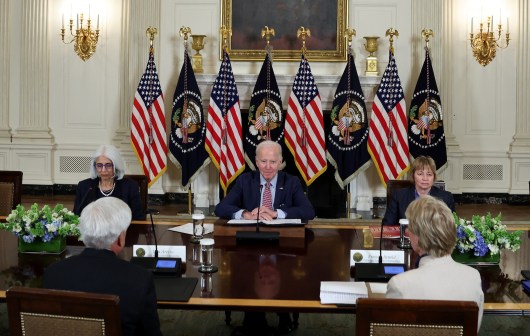Why does blockchain make people so mad?

There’s nothing that unites civic technologists quite like the blockchain.
Among many members of this community, any mention of the use of blockchain technology for government can elicit a negative response — anything from an eye roll to an irate Twitter thread. More than any other emerging technology, perhaps, blockchain is the butt of so many jokes. It’s a poster child for hype, shiny object syndrome and government tech solutionism.
And sure, all hyped emerging technologies experience a backlash at some point. But the response to this one often seems different, more visceral.
So what’s the deal?
Wait, what’s the blockchain?
First, it probably helps to define what blockchain is.
The National Institute of Standards and Technology offers this definition: “Blockchains are tamper evident and tamper resistant digital ledgers implemented in a distributed fashion and usually without a central authority.”
Blockchain is the underlying technology that powers bitcoin and other cryptocurrencies, but its advertised potential extends way beyond this application. All conversations for this article focused on blockchain as a separate and distinct technology from any cryptocurrencies.
Much ink has been spilled — often by would-be purveyors — about the potential benefits of using blockchain in government. A handful of agencies are spending money on it, and analysts expect this investment to grow.
A report by the Data Foundation (sponsored by Booz Allen Hamilton) argued that “the emergence of blockchain holds promise for the federal government to foster trust and greater transparency about certain data activities.” The report discusses a number of federal projects (mostly pilots or proofs of concept) at agencies like the Department of Health and Human Services, Treasury and General Services Administration. But while the report is generally blockchain-positive, it is also careful to note that the technology is “not a panacea.”
Despite pockets of strong interest in the technology, a number of technologists told FedScoop that “blockchain” and “government” are a fundamental contradiction in terms. And that brings us to the first reason people are so mad.
The oxymoron issue
The “oxymoron issue,” as we’ll call it here, is part definitional and part technical.
The NIST definition states that blockchain “usually” operates without a central authority. Government, however, is the quintessential central authority figure. So does using this technology mean that a government agency must give up its centralized power?
Usually not. Most ongoing government blockchain projects use “permissioned” blockchains, where users must be explicitly authorized by some authority. These contrast with the “permissionless” version, in which anyone can participate.
While both of these are official types of blockchain networks, some technologists argue that by making it work for government, blockchain loses its blockchain-ness.
As a blog post written by Scott Haselton put it, “’Blockchain’ found in enterprise are private instead of public, they require permission vs being permissionless, they are not distributed on millions of servers/computers but rather on a few selected servers, they are based on trust of authority that verify transactions on the chain vs being trustless.”
All of the “cool” components of the technology, the post goes on, have been “stripped away.”
And what you’re left with, the argument goes, is really just a database. Which brings us to the second reason why people get so mad.
The use case issue
This boils down to the gulf between what blockchain is actually useful for, and the much wider range of problems it is often proposed as a solution to.
“It is a technology that is effective for such a small and specific set of activities,” Lane Becker, whose resume includes Code for America and 18F, told FedScoop. “And for everything else, it’s wildly either unnecessary or inefficient.”
“There’s a very, very narrow set of use cases for blockchain,” Nate Ashton, director of accelerator programs at Dcode, agreed.
There’s a popular Department of Homeland Security flowchart that makes this point. You probably know the one. As presented in a NIST paper, the flowchart aims to “help one determine whether a blockchain may be needed for a development initiative.”
The flowchart guides readers through six layers of questions about what they need, requiring a “yes” at every juncture. (If you answer no to any of the questions, though, it does suggest an alternative tool). Finally, at the very end of this journey, the flowchart concedes that, if you made it this far, “you may have a useful Blockchain use case.”

The famous flowchart. (DHS)
It’s not exactly a glowing endorsement of blockchain’s wide utility.
Ashton, for one, is open to the idea that there may be interesting applications for blockchain in government. That said, “the relevant use cases that do exist in government — they haven’t been proven out anywhere yet,” he said. “There’ve been some tests in Sweden, I think Estonia has been doing some stuff, but none of its really gotten to the scale where we can say this is definitely the right way to go.”
Shannon Sartin, executive director of Digital Service at the Centers for Medicare and Medicaid Services, agreed with this point. “Blockchain’s been the hype for a couple years now, as far as emerging technologies go … and I have yet to see a single use case,” she told FedScoop.
The solutionism issue
But Sartin’s No.1 issue with blockchain is a little different. It’s about the whole approach. It’s backward, she says.
“When you talk about solutions before you talk about problems, independent of the technology that you’re talking about, there is a 100% chance that you’re wrong,” she said. Blockchain, she argues, is often pitched to government this way — as a one-stop-shop for problem-solving of all kinds. This disconnect between the technical problems that actually exist and the proposed solution is annoying.
Becker knows the feeling. “One of the more frustrating things in any sort of agency environment is… you’re like, ‘hey, we have some like fundamental problems we need to fix,’” he said. “And it’s very frustrating to be talking to executives who are like, ‘yeah, yeah, yeah, we’ll get to those but first let’s play with this shiny object over here.’”
Becker acknowledges that if there’s a positive takeaway here, it’s that emerging technologies can be a catalyst for creative ideas — ideas that may not end up involving blockchain at all.
“New technologies, like AI and like blockchain, can get people thinking very differently,” he said. “It can open their eyes up to the possibility that technology can solve a problem that they had previously dismissed or decided to accept.”
Often, however, blockchain solutionism comes from people who don’t understand what the problems in government are, and haven’t bothered to find out.
“For those of us who spent a lot of time trying to make the government better, it’s kind of insulting for someone else to pull a technology out of a hat, not understand how the technology is valuable or the problems that they’re trying to solve in government and then get attention from Silicon Valley and the press,” Josh Tauberer, a civic hacker and the creator of GovTrack, told FedScoop.
“But I don’t want to blame it on emotions,” he continued. “From my perspective… it really is just that most of the time these blockchain projects are truly a waste of taxpayer funding and the time of everyone involved in government.”




